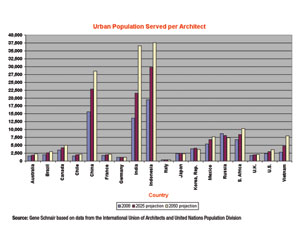Licensed U.S. architects working globally, a group that is growing, need support from the American Institute of Architects in several ways, including promoting and endorsing a strategic plan that enables U.S. architects to gain professional practice licenses in foreign jurisdictions. AIA also should endorse the International Union of Architects’ (UIA) professional advisory standards, international education standards and international accreditation/validation standards.
“The AIA should be advocating practices that enable its members to diversify their geographic, civic and cultural involvements,” said Thomas Vonier, an architect based in Paris and AIA’s international director.
These recommendations and others relating to working globally were issued by the AIA international committee to the AIA board of directors at “Convention 2010, Design for the New Decade,” held on June 10-12 in Miami. The convention drew more than 17,000 attendees.
According to the international committee advisory group, 85% to 95% of the large AIA member firms currently practice globally. This translates to 30% of U.S. design firms, which employ 26,000 architects. There are more than 1,500 AIA members living overseas.
The most rapid economic and population growth will occur in developing countries in which there are the fewest number of architects per capita, says the advisory group. In Indonesia’s cities, there is only one architect for nearly 30,000 people, compared with one architect for 2,500 people in the U.S. In China’s cities, one architect currently serves 15,000 people. In India’s cities, one architect serves some 14,000 people.
The gaps are expected to widen. In 2050 projections, in Indonesia’s cities, there will be one architect for every 37,500 people; in China, one for every 28,000 people; and in India, one for every 36,000 people.
“There’s an opportunity for U.S. architects to serve,” said Gene Schnair, a partner in the San Francisco office of architect-engineer Skidmore, Owings & Merrill and an advisory group member.
But, he added, for this to happen, architects need the support of multinational free-trade agreements, such as those crafted by the U.S. and other groups, including the World Trade Organization, and licensure regulatory agreements, currently administered by the National Council of Architectural Registration Board (NCARB).
Regulatory agreements include cooperation agreements, addressing a specific project; practice-in-a-host-nation agreements, which allow foreign architects to associate with a local registered architect-of-record; and mutual recognition agreements (MRAs). “We’d like MRAs with as many countries as possible, but especially in areas with the greatest needs and demands,” said Schnair. AIA should ask NCARB to set a time frame for concluding MRAs currently in progress, said the committee.
But MRAs are complicated. For example, an MRA between the U.S. and Australia was mutually abandoned last year. Further, the Architects’ Council of Europe made little progress in discussions last year on the subject of MRAs, said Schnair.
One obstacle to licensing abroad is that there is no national licensing body in the U.S. Licenses are granted by the individual state.
There is some hope. AIA is working with the professional practice commission of the UIA, which represents 1.3 million architects worldwide in 116 nations. The commission is crafting a model MRA that would allow any country to participate. There’s “great work being done,” said Schnair. An update on progress is expected in October.




Post a comment to this article
Report Abusive Comment